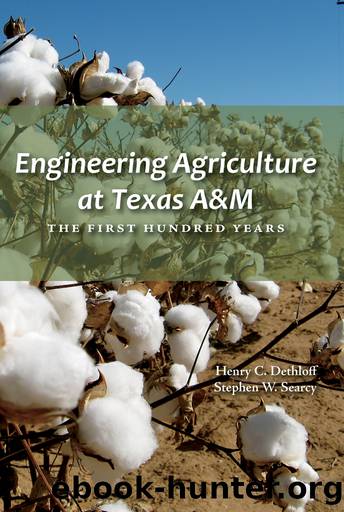Engineering Agriculture at Texas A&M by Dethloff Henry C.;Searcy Stephen W.;

Author:Dethloff, Henry C.;Searcy, Stephen W.; [Dethloff, Henry C.]
Language: eng
Format: epub
Publisher: Texas A&M University Press
Published: 2015-08-15T00:00:00+00:00
FIG. 7.3 The Ogallala Aquifer is a major water source for the Northern and Southern High Plains of Texas. United States Geological Survey (USGS).
Following the passage of the Water Resources Act, Price Hobgood, head of the Department of Agricultural Engineering, with Professor Earnest T. Smerdon, met with A&Mâs President James Earl Rudder, urging that Texas A&M be designated by the legislature to host Texasâ Water Resources Research Institutes, and thus entitled to research funding provided by Congress under the Act. Rudder agreed, and suggested that Smerdon contact Texasâ state Senator William T. âBillâ Moore to expedite that restructuring. He did so, and with Mooreâs assistance, TWRI became one of fifty-four autonomous units operating under the National Institute for Water Resources. TWRI operated under the auspices of Texas A&Mâs College of Agriculture and Life Sciences in cooperation with the Texas Agricultural Experiment Station and Agricultural Extension Service. Earnest Smerdon was named as the first director of TWRI, and served that role for many years, and for a number of those years, the Texas Water Research Institute was physically housed with the Department of Agricultural Engineering in Daniels Scoates Hall. Smerdon left Texas A&M and held various academic administrative roles until he retired from the University of Arizona, where he was professor of hydrology in the Water Resources Department, and vice-provost and dean of the College of Engineering and Mines, from 1988 to 1993. The water resources career that Smerdon began at Texas A&M resulted in his selection as a member of the National Academy of Engineering.
Water was not the only resource which was being depleted by the growing populations of Texas and the United States. Rapidly growing populations, coupled with expanding industry, increased the nationâs energy demand. The energy supply disruptions that occurred in the 1970s were a wakeup call for the entire United States, even an energy-producing state like Texas. Alternative energy resources became increasingly critical as the United Statesâ use of traditional energy resources exploded. Alternative energy resources included atomic, solar, and windâand biomass fuels from and for agriculture. Charlie Coble, for example, found efficient processes for the production of ethanol from cereal feedstocks. Wayne LePori, Ed Hiler, Bill Stout, Ernest T. Smerdon, Cady Engler, and other faculty conducted research and authored papers and studies on the production and use of biomass fuels for and from agriculture. Biological engineering became a byword of the Department of Agricultural Engineering, and eventually, a part of the departmentâs nomenclature, while the agricultural, academic, and technological world of agricultural engineering began to expand and diversify.
Public interest in alternative energy sources, such as biomass fuel, and a growing interest in and concern about the environment, contributed to the growth of biological research and studies within the academic world of agricultural engineering. One reality contributing to that concern involved the growing public use of DDTâdichloro-diphenyl-trichloroethane. Developed in 1939 by Paul Hermann Müller, DDT the most powerful pesticide the world had ever known seemed to be miraculous when first used in the South Pacific islands during World War II to eradicate malaria-causing mosquitoes.
Download
This site does not store any files on its server. We only index and link to content provided by other sites. Please contact the content providers to delete copyright contents if any and email us, we'll remove relevant links or contents immediately.
The World Almanac and Book of Facts 2021 by Sarah Janssen(837)
The emperor wears no clothes by Jack Herer(352)
The Crises of Civilization by Dipesh Chakrabarty(306)
The Way Home by Unknown(302)
History of India: A History In 50 Events by Hourly History(268)
Hidden Links by Zac Sangeeth & Sangeeth Varghese(245)
Darius in the Shadow of Alexander by Pierre Briant(244)
The History of Human Marriage by Edward Westermarck(236)
Prehistoric Europe by Champion Timothy. Whittle Alasdair. Shennan Stephen. Gamble Clive(234)
A Military History of the Cold War, 1962â1991 by Jonathan M. House(231)
Flood Legends: Global Clues of a Common Event by Charles Martin(220)
History of the Jews: An Enthralling Guide from Ancient Times to the Present (Religion in Past Times) by Wellman Billy(213)
Chinese History: 500 Interesting Facts About China (Curious Histories Collection) by Ahoy Publications(197)
The Education of Historians for Twenty-First Century by Thomas Bender; Philip F. Katz; Colin A. Palmer(196)
Big Tent by Mallory Factor(186)
Ancient Roman Sports, A-Z : Athletes, Venues, Events and Terms by David Matz(181)
Mark Of The Scots - Cl by Duncan A. Bruce(177)
Other Pasts, Different Presents, Alternative Futures by Jeremy Black(177)
The Philosophy of Historiography by John Lange(177)
